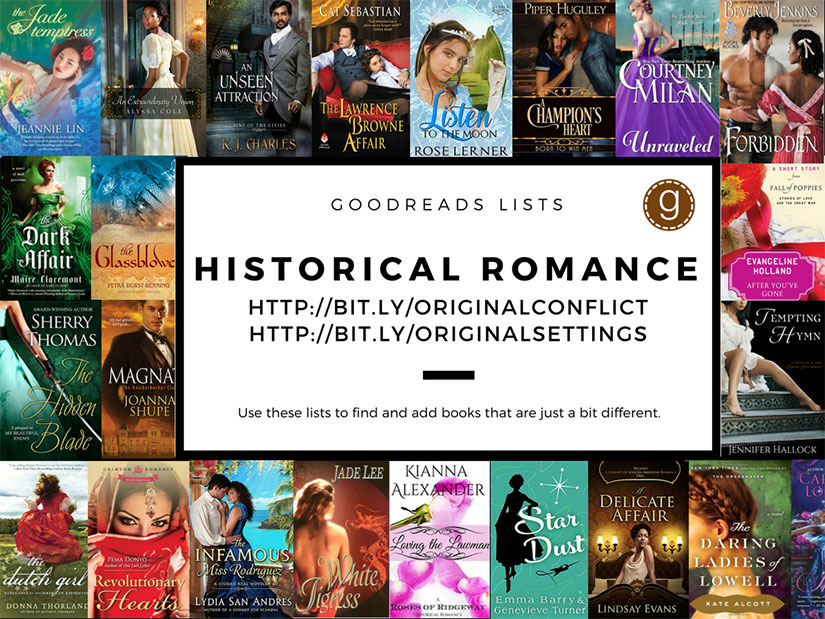In part one of History Ever After, I illustrated how bestselling historical romance is dominated by selectively accurate British peerage chronotopes, especially the Regency. So what, you ask? A good book is a good book. Any reader can enjoy an exciting duke romance. I agree! I read everything.
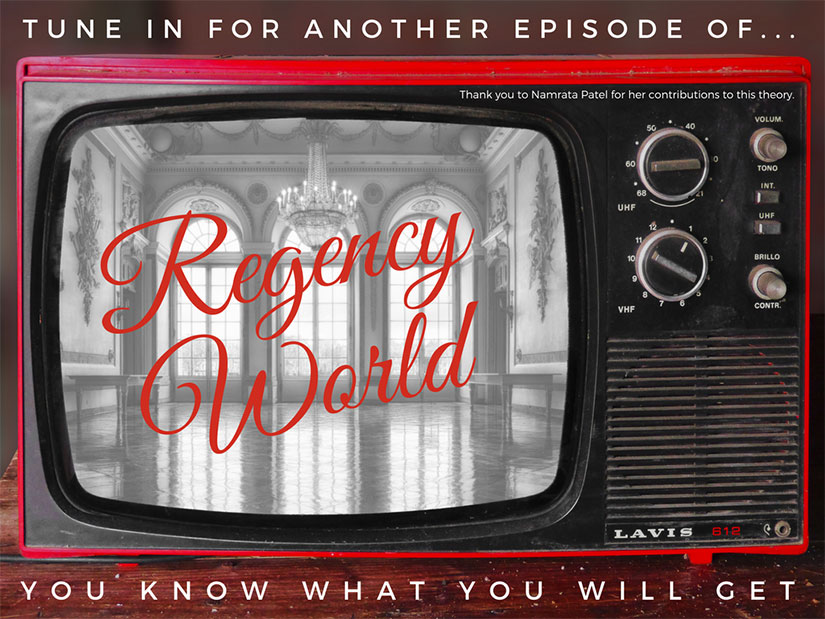
However, the aggregate impact of these chronotopes can be harmful to our understanding of history, to the romance market as a whole, and particularly to authors of diverse books.
Mirrors and Windows
A popular concept in the discussion of multicultural books is the question of whether fiction is meant to reflect one’s own identity and experiences, or provide insight into the identity and experiences of another. British peerage historical romance bestsellers are mirror texts for the dominant culture and windows text for readers of color. We need more of the reverse too.
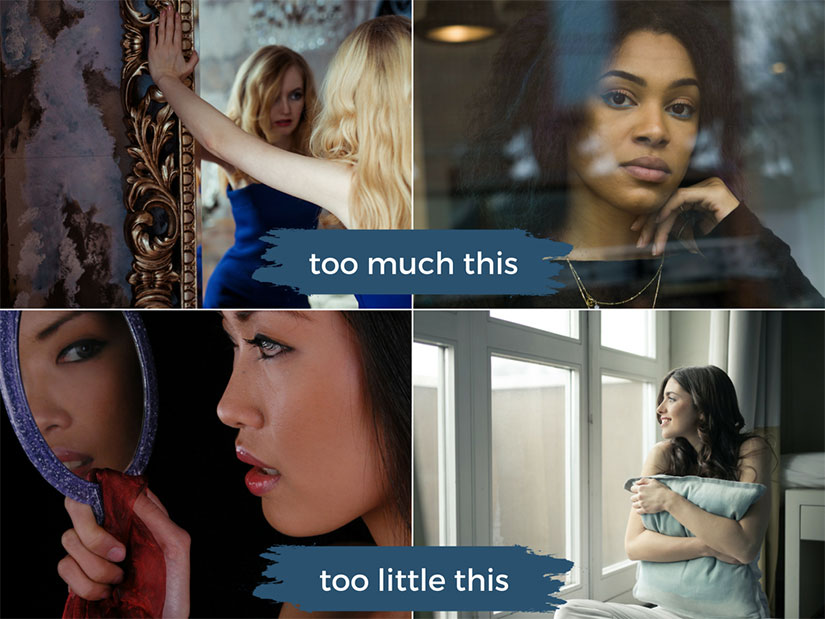
This is not a new concept. In 1965 Nancy Larrick wrote up a study in which only 6.7% of children’s books had one or more African American character. This was a problem for African American children who could not see themselves in books as heroes, wizards, or just boys and girls. But Larrick saw another problem, too. She wrote that “the impact of all-white books upon . . . white children is probably even worse. . . . There seems to be little chance of developing the humility so urgently needed for world cooperation, instead of world conflict, as long as children are brought up on gentle doses of racism through their books.”
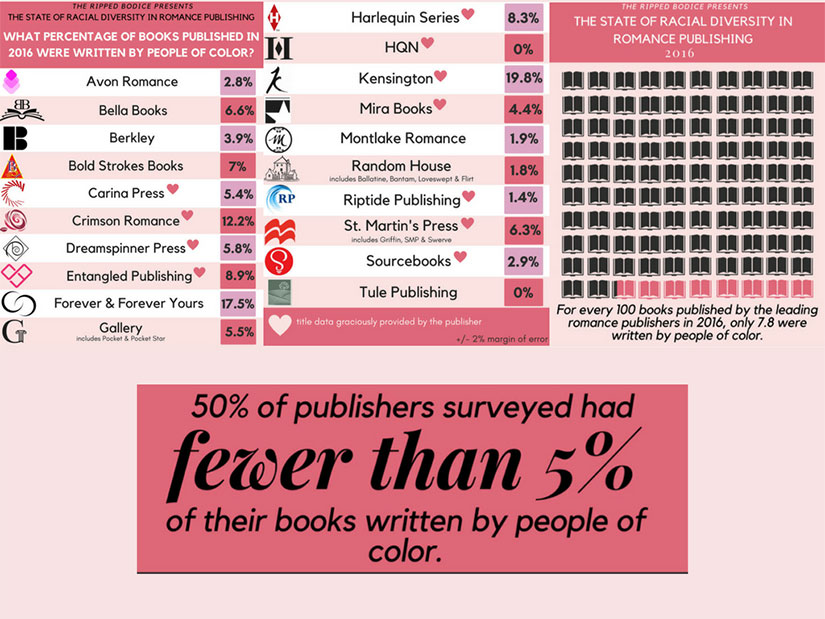 Fifty years on from Nancy Larrick’s study, we’re not doing any better in Romance, according to the Ripped Bodice’s State of Racial Diversity in Romance Publishing Report.
Fifty years on from Nancy Larrick’s study, we’re not doing any better in Romance, according to the Ripped Bodice’s State of Racial Diversity in Romance Publishing Report.
[Edited to add in March 2021: Professional statisticians Nick and Ari have published a full report on data and ethics concerns in TRB’s reporting. As there are no better statistics available yet, and because this post is representative of the presentation that I gave in 2018, I will not remove my text below. Based on the experience of BIPOC authors, as related to me personally and on social media, I believe the conclusions drawn below are still relevant generally, but they should not be relied upon for statistical accuracy. This warning applies only to the TRB report, not the Lee & Low study that is subsequently mentioned.]
Half of the publishers surveyed in 2016 had only 5% or fewer of their books written by people of color. While diverse books do exist, it is not enough—and too often they are published independently, without traditional backing or wide print distribution. This is a self-fulfilling prophecy: if you publish only what is selling best now, then future bestsellers will be confined to this same limited chronotope—a vicious cycle. True to form, the numbers are worse in 2017 than in 2016: 10 out of 20 publishers surveyed had fewer books published by authors of color than the year before.
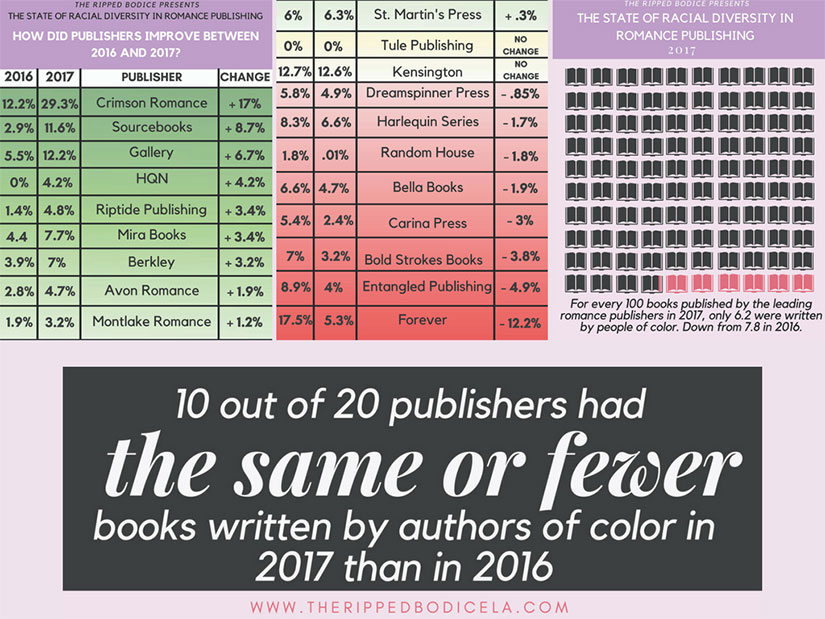
Part of the problem is the lack of diversity WITHIN publishing. This 2015 Diversity Baseline Study by Lee & Low Books, a multicultural publisher that is minority-owned, illustrates the problem. These numbers do not include two of the Big Five publishers: Simon & Schuster (which includes Pocket Books) and HarperCollins (which includes romance behemoths Avon and Harlequin). Given the Ripped Bodice numbers, though, I cannot imagine their inclusion would make the industry more diverse, at least on the author side.
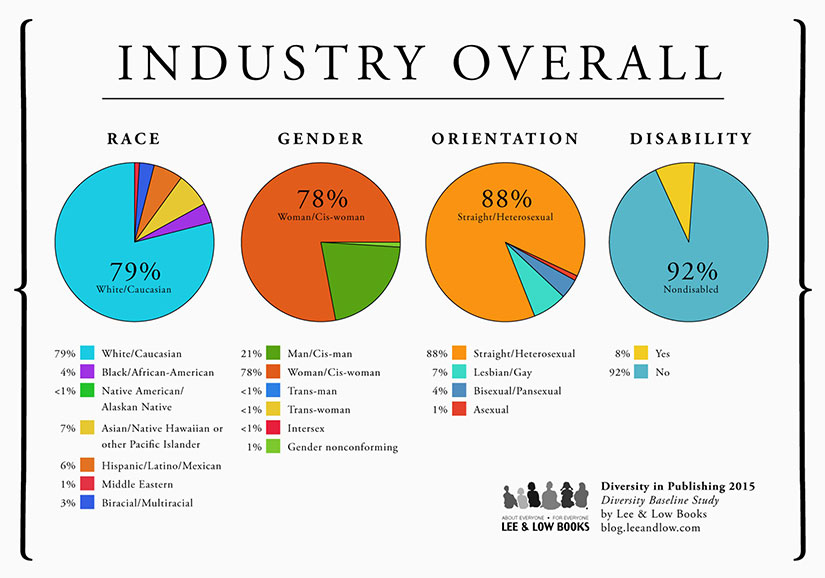
Last year, Penguin UK announced the new company-wide goal for “both our new hires and the authors we acquire to reflect UK society by 2025.” If American publishers tried this, they would need to target the following numbers, based on 2016 estimates by the United States Census Bureau: 61% white, 17% Latino, 13% Black, 6% Asian, 2.6% mixed race, 1.3% American Indian, and more. The numbers Lee & Low show us are far from such a representative target.
Everyone needs both mirror texts and window texts. We need them in different balances at different times in our lives, but we need both. We need diverse historical romance to be pushed with the same kind of institutional support that an Avon Regency duke book gets. Why isn’t that happening?
Misunderstanding History
Part of the reason is we misunderstand history. There is damage done when people believe that the chronotope is history. For example, if one only read the British peerage chronotopes, one might not know that people of color existed in Europe from Rome to the Middle Ages and beyond. Examples from art of the period not only proves this, but also that people of color existed at every level of society, too. Medieval Europeans discriminated more by class than race, a word they did not have.
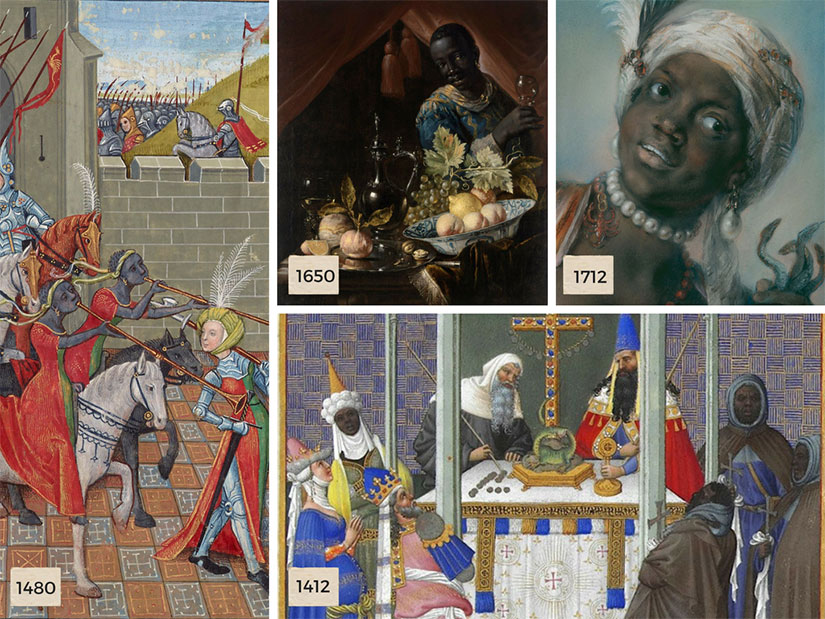
And do not be fooled: people are getting their history from the genre. Bobbi Dumas wrote an article for NPR entitled “Don’t Know Much About History? Read A Romance.” She quoted Sabrina Jeffries as saying, “Everything I know about the personal cost of Waterloo, I learned from Regency-set historical romances.” Dumas also claimed that “Georgette Heyer wrote such a fine treatment of [Waterloo] in An Infamous Army that it ended up on a reading list for students at Sandhurst, the British military academy.” African American author Beverly Jenkins calls her books “edutainment: entertainment and education,” which may be the most accurate way of putting it. “There’s no test on Friday,” she says, “so [the readers just] drink up the history. They just inhale it.”
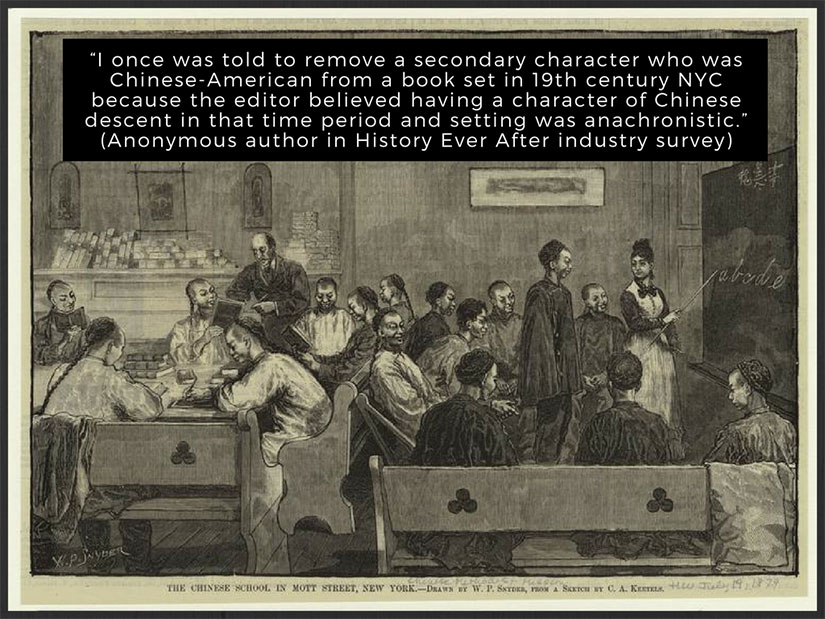
But which history do readers inhale in bestselling chronotopes? One anonymous author in my survey reported:
I once was told to remove a secondary character who was Chinese-American from a book set in 19th century NYC because the editor believed having a character of Chinese descent in that time period and setting was anachronistic. It was in fact not—I could and did provide ample historical evidence of this—and I refused to change it because I believed not only did it damage the historical integrity of the work, but it also contributed to the white-washing of NYC history.
This editor should have known better. She or he may have even lived in New York. When people in control of publishing have such a warped impression of history by the books they have been the gatekeepers over, then we are in a terrible feedback loop of ignorance.
Perceived Accuracy as a Double Standard
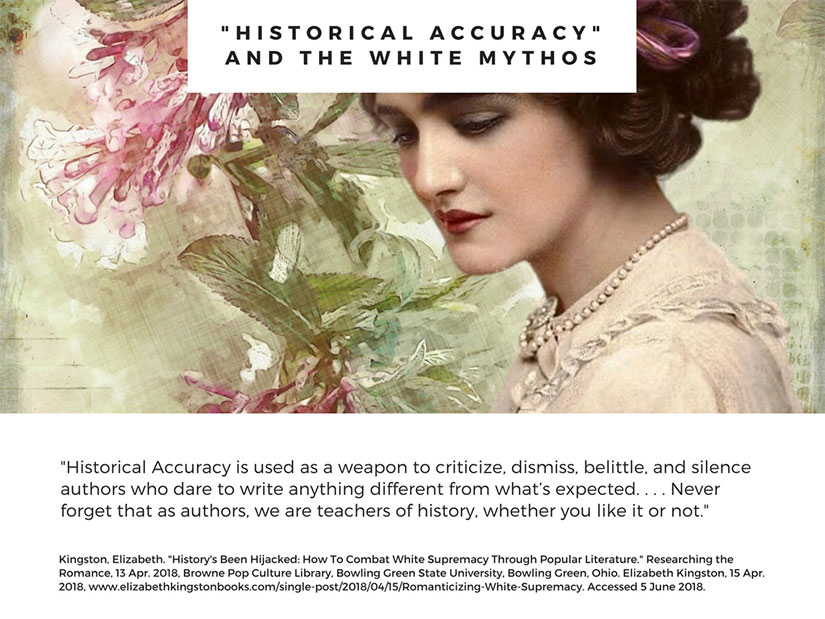
Perceived accuracy is a dangerous weapon, and it can hurt an author’s critical reception by people who should know better. Let me show you how this works.
In the AAR Top 100 romance novels process, there were no books by African American authors on the original stage one voting lists. AAR rushed to change the stage one list after Twitter blew up, but they still left off the Romantic Times 2018 Book of the Year Award winner, An Extraordinary Union by Alyssa Cole. I believe it is a particularly relevant example. First, AAR had the ambition to make such a list, so clearly they consider themselves an authority in the genre. Second, even before it became RT’s (last) Book of the Year, it was already a very, very highly praised book. An Extraordinary Union is the story of a free Black woman who goes undercover as a slave in the American Confederacy to spy for the Union and falls for a white pro-Union spy she uncovers along the way. What an interesting story, you say. And outside the British peerage chronotope! So why did AAR omit it? Because they had given it a C.
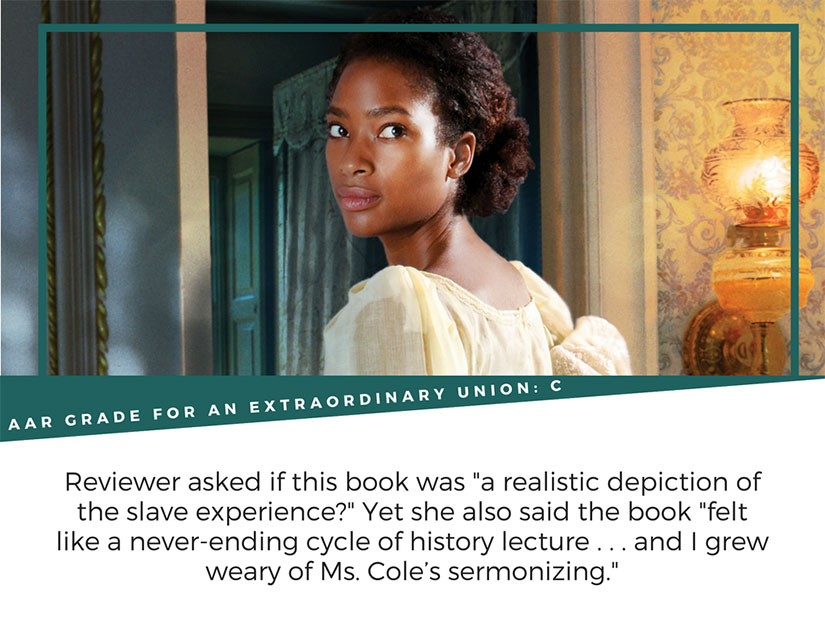
One of the reviewers questioned whether this book provided a “realistic depiction of the slave experience”? If it were realistic to the slave experience, there would be no happily-ever-after. There was no HEA for slaves. When history endangers the HEA, the HEA comes first because this is romance. It is usually a minor accommodation, as it was in this case. (For example, one reviewer claimed that the heroine Elle had “an awful lot of freedom” for her spying, but this same reviewer later stated that she would still have liked to see “more emphasis placed on the spy portions of the story.”) I should point out that Cole’s book was a very well researched piece of fiction loosely based on a real person, Mary Bowser. Its treatment of everyone—from Black slaves to white Confederates—is highly nuanced and layered. It also includes a bibliography. [Edited to add: As pointed out in the Book Thingo podcast on romance lists, the real and harrowing risks Elle faced in her role as a slave were explicitly laid out in the book.]
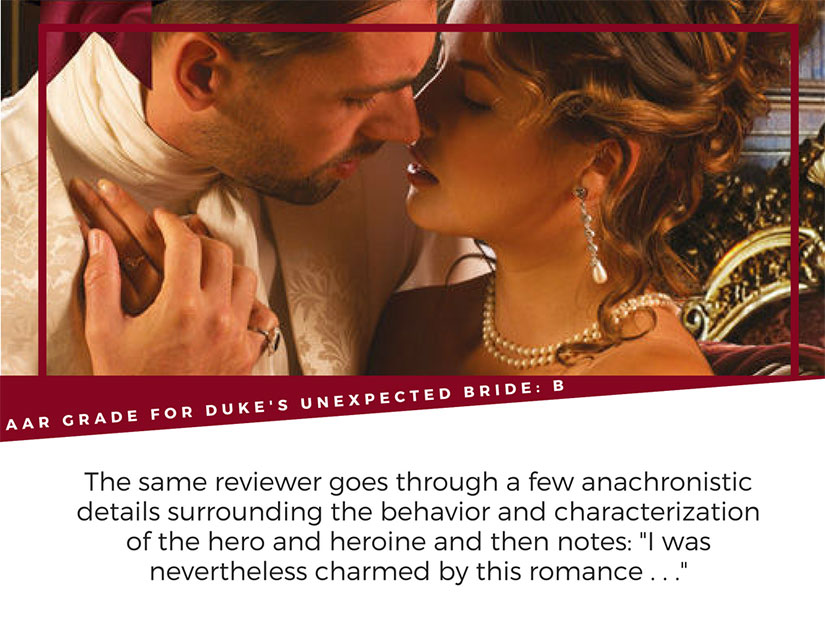
One month later, the same primary AAR reviewer blasted the historical flaws of a Regency duke book: “Ladies didn’t run amok unchaperoned in London, and dukes didn’t volunteer for the job without any prior introduction or connection to the lady in question.” She also wrote that “it’s awfully convenient how often [Max] breaks his own rules and finds himself alone with Sophie; and Sophie, country bumpkin, transforms into a sexually confident seductress.” The reviewer was “nevertheless charmed” and gave it a B. One reason this happened was because the Regency book was judged against a chronotope, not real history.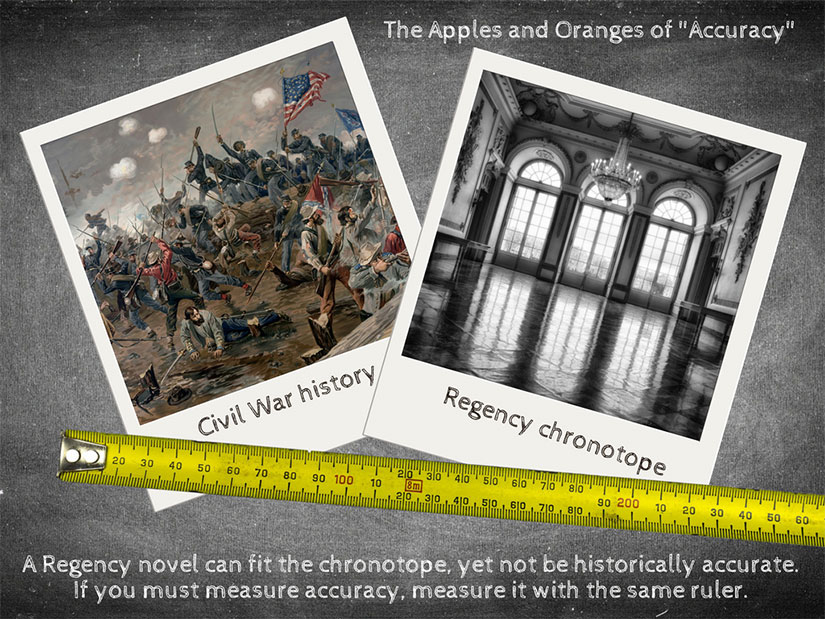 This is a double standard. Since there is not a pre-established model for diverse Civil War romance, An Extraordinary Union was compared to the inappropriate standard of historical fiction. No romance novel will stand for everything about slavery or the civil war. It can and should be a window into that history, but the world-building has to be done very explicitly to allow for a romance to develop between two characters and to make room for their HEA. Alyssa Cole’s Loyal League series is immersed in extensive research, down to a pro-Union insurrection within the Confederacy—an understudied part of the Civil War—but critics need to allow Cole at least a portion of the same authorial agency that they give to Regency duke stories. Overall, this series is more accurate than much in the Regency chronotope.
This is a double standard. Since there is not a pre-established model for diverse Civil War romance, An Extraordinary Union was compared to the inappropriate standard of historical fiction. No romance novel will stand for everything about slavery or the civil war. It can and should be a window into that history, but the world-building has to be done very explicitly to allow for a romance to develop between two characters and to make room for their HEA. Alyssa Cole’s Loyal League series is immersed in extensive research, down to a pro-Union insurrection within the Confederacy—an understudied part of the Civil War—but critics need to allow Cole at least a portion of the same authorial agency that they give to Regency duke stories. Overall, this series is more accurate than much in the Regency chronotope.
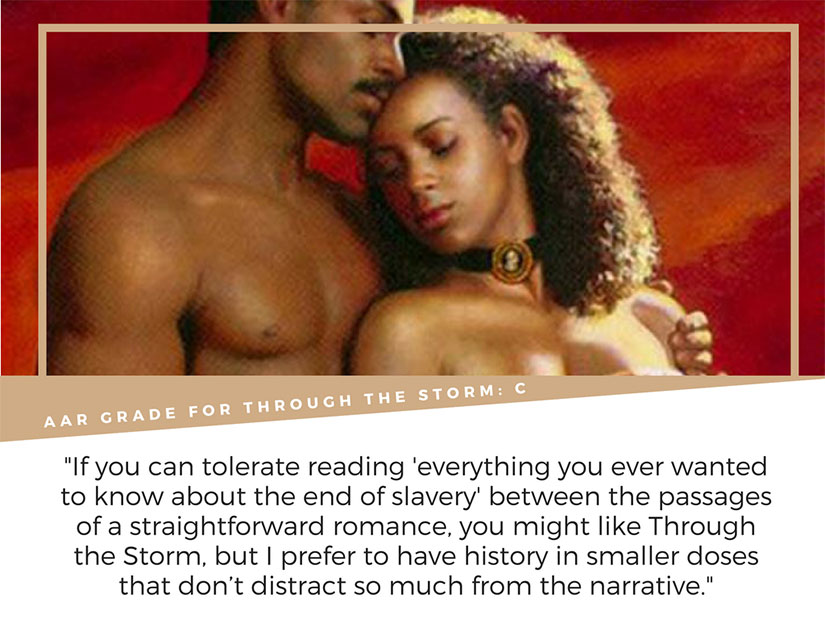
But be careful: historical world-building also opens an author to the criticism of including too much history in the romance. This was true for Through the Storm by Beverly Jenkins on AAR. Jenkins HAS to do this historical work because it is not a chronotope that the reader understands before page one. But, again, both Jenkins and Cole include bibliographies in the back of their books. How many Regency duke stories do? And yet it seems there is no way to win: these authors are criticized for too much history or too little history.
inertia or incentive
Are the mirror texts of the dominant culture creating bias? AAR is not included in the diversity of reviewers study by Lee and Low Books, but I looked through their site. By self-identification, there seemed to be 2 reviewers of South Asian descent? I saw no African American representation, though there were a few reviewers under pseudonyms with no identifying details so I cannot be sure. I do know that AAR’s historical categories only include European and American settings. They have ”Indian Historical Romance,” but it is about Indigenous Americans (“American Indians”), not Indians from India. I did not set out to pick on one review site—but, again, if you aspire to poll readers and rank romance novels, your reviews and ratings do matter.
[Edited to add: based on inquiries from an AAR reviewer, I acknowledge that other review sites may not be more representative. I did not break down the ethnicity and race make-up of other romance review sites, like Dear Author or Smart Bitches, Trashy Books, the two the reviewer asked me about. The Lee & Low Books study (above) shows that lack of representation in published review journals (also asked about by the AAR reviewer) is a significant problem. I focused on AAR‘s reviews in this study because of the visibility of the Top 100 list during the period of my research, along with the bias issues in the survey process.]
Still, no single book, publisher, reviewer, or reader is the problem. The aggregate is the problem. In the aggregate, if authors writing diverse historical romance, particularly authors of color, are not getting traditional publishing support (which the Ripped Bodice statistics show), and they are not getting critical acclaim because of an unequal standard, then they will have a harder time finding their market. They could have a harder time being mainstream bestsellers. And then traditional publishers might say “those books don’t sell,” which is a way to obscure the fact that publishing has helped establish a market that is unfriendly to these books.
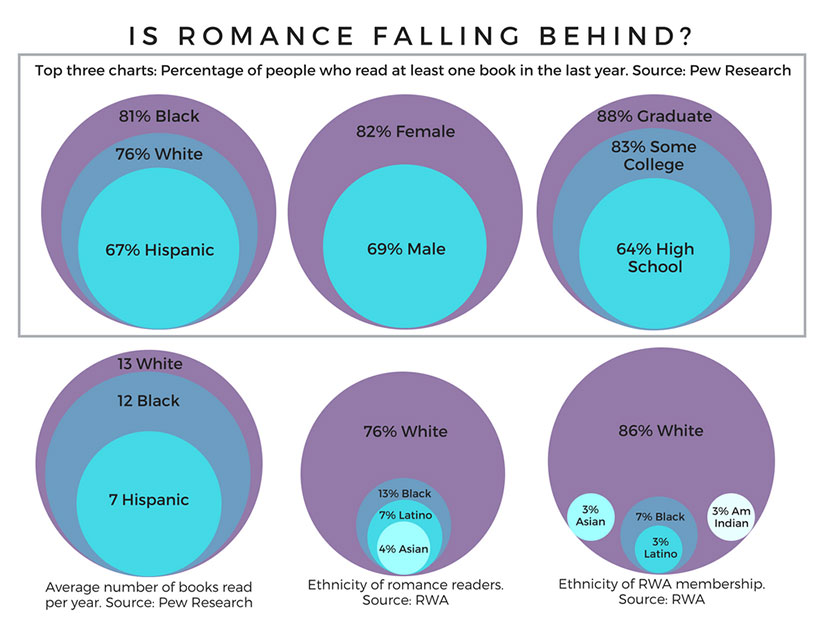
They will be sorry. Pew Research found that the most likely person to pick up a book—in any genre and any publishing format—is a Black woman who has been to college. Reading is an inclusive activity. Moreover, the younger the reader, the more likely she or he is to be non-white in the United States. Yet RWA’s own study of romance readers and their membership is significantly less diverse than the nation as a whole. Diversifying the books in the genre should be a matter of survival for the industry—as well as a matter of variety and accuracy.
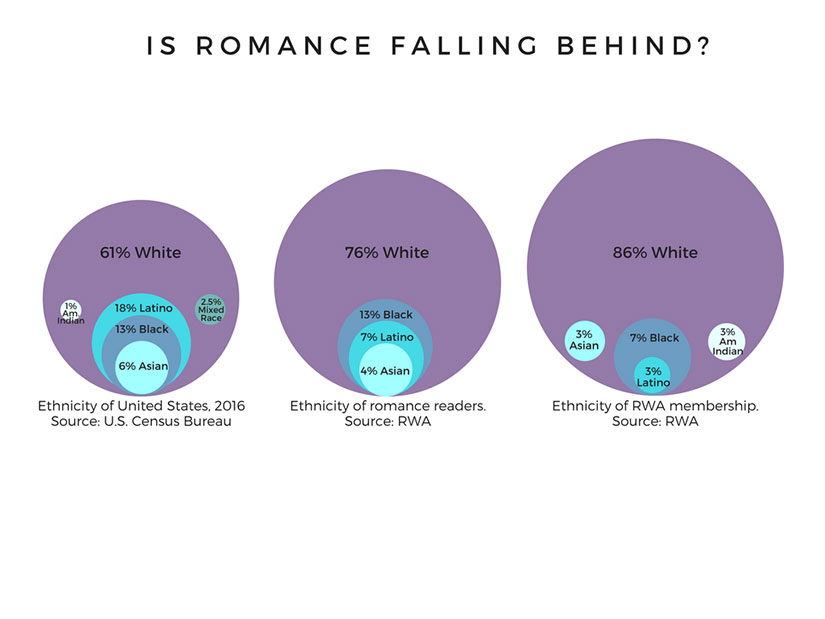
Is there some optimism from my survey of 336 historical romance readers that they are interested in fresh, new settings outside the British peerage chronotope? If we assume the readers who answered these questions were at least as white as the United States as a whole (61%), then many white readers also want diverse books.
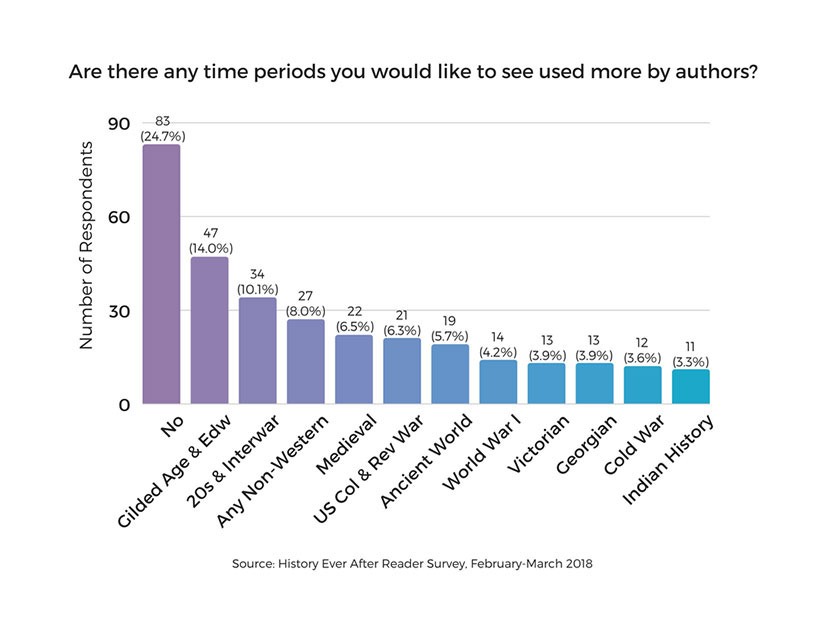
Romance is a commercial industry, and readers can choose to read as they wish. But do they understand that their Regency dukes are a fabricated chronotope? More importantly, do industry professionals realize it? If they focus only on current bestselling trends, they will crowd out other books, alienate future readers, and weaken the industry itself by making it less elastic.
Change is happening fast. Vested interests are facing a challenge in one of the most money-dominated industries in America: politics. On 28 June 2018, the 28-year old Bronx hometown hero Ocasio-Cortez handed a primary defeat to the 4th ranking Democrat, Chair of the House Democratic Caucus, and ten-term incumbent in the US House of Representatives, Joe Crowley—a white man. This is how fast markets can change. Ocasio-Cortez had no corporate donations and 1/16th the funding. And the New York Times missed it.
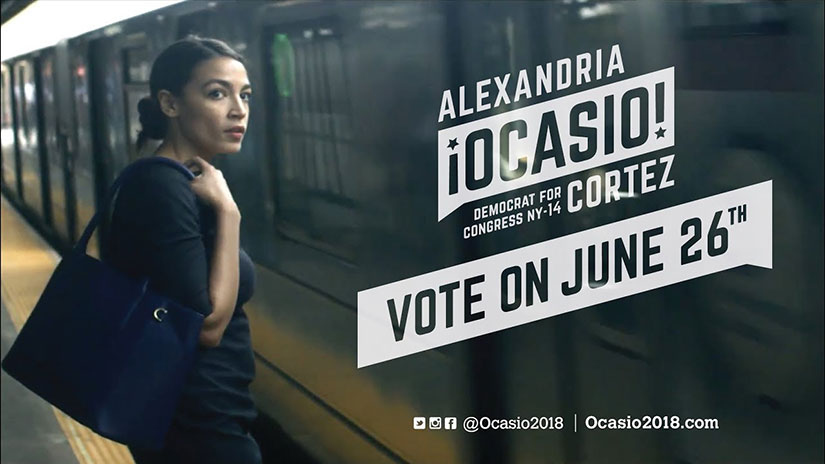
Similarly, will New York publishing houses miss a similarly sudden shift in historical romance readership? If they do, we need to help each other find books that are a little different: set somewhere else, with more political plot lines, or with broader character representation. Help me crowd-source these lists on Goodreads so we can find the historical romances we need for the 21st century:
(To go back to the History Ever After content page and find the handout flyer, click here.)


